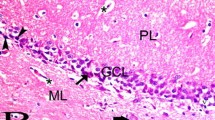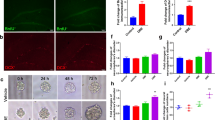Abstract
Lemon balm, leaves of Melissa officinalis L., has been used for anti-anxiety and spasmolytics. We observed the extract of Melissa officinalis L. (MOE) on cell proliferation and neuroblast differentiation in the hippocampal dentate gyrus (DG) of middle-aged mice (12 months of age) using Ki67 and doublecortin (DCX), respectively. We also observed changes in corticosterone, GAD67 and GABA-transaminase (GABA-T) to check their possible mechanisms related to neurogenesis. We administered 50 or 200 mg/kg MOE to the animals once a day for 3 weeks. For labeling of newly generated cells, we also administered 5-bromodeoxyuridine (BrdU) twice a day for 3 days from the day of the first MOE treatment. Administration of 50 or 200 mg/kg MOE dose-dependently increased Ki67 positive nuclei to 244.1 and 763.9% of the vehicle-treated group, respectively. In addition, 50 or 200 mg/kg MOE significantly increased DCX positive neuroblasts with well-developed (tertiary) dendrites. Furthermore, MOE administration significantly increased BrdU/calbindin D-28 k double labeled cells (integrated neurons into granule cells in the DG) to 245.2% of the vehicle-treated group. On the other hand, administration of MOE reduced corticosterone levels in serum and decreased GABA-T levels in the DG homogenates. These results suggest that MOE increases cell proliferation, neuroblast differentiation and integration into granule cells by decreasing serum corticosterone levels as well as by increasing GABA levels in the mouse DG.






Similar content being viewed by others
References
Arida RM, Scorza FA, Scorza CA, Cavalheiro EA (2009) Is physical activity beneficial for recovery in temporal lobe epilepsy? Evidences from animal studies. Neurosci Biobehav Rev 33:422–431
Schaeffer EL, Novaes BA, da Silva ER, Skaf HD, Mendes-Neto AG (2009) Strategies to promote differentiation of newborn neurons into mature functional cells in Alzheimer brain. Prog Neuropsychopharmacol Biol Psychiatry 33:1087–1102
Alvarez-Buylla A, Lim DA (2004) For the long run: maintaining germinal niches in the adult brain. Neuron 41:683–686
Liu Z, Fan Y, Won SJ et al (2007) Chronic treatment with minocycline preserves adult new neurons and reduces functional impairment after focal cerebral ischemia. Stroke 38:146–152
Ohm TG (2007) The dentate gyrus in Alzheimer’s disease. Prog Brain Res 163:723–740
Li B, Yamamori H, Tatebayashi Y et al (2008) Failure of neuronal maturation in Alzheimer disease dentate gyrus. J Neuropathol Exp Neurol 67:78–84
Rodríguez JJ, Jones VC, Tabuchi M et al (2008) Impaired adult neurogenesis in the dentate gyrus of a triple transgenic mouse model of Alzheimer’s disease. PLoS One 3:e2935
Gage FH (2000) Mammalian neural stem cells. Science 287:1433–1438
Limoli CL, Giedzinski E, Baure J, Doctrow SR, Rola R, Fike JR (2006) Using superoxide dismutase/catalase mimetics to manipulate the redox environment of neural precursor cells. Radiat Prot Dosimetry 122:228–236
Kennedy DO, Little W, Scholey AB (2004) Attenuation of laboratory-induced stress in humans after acute administration of Melissa officinalis (Lemon Balm). Psychosom Med 66:607–613
Ulbricht C, Brendler T, Gruenwald J et al (2005) Lemon balm (Melissa officinalis L.): an evidence-based systematic review by the Natural Standard Research Collaboration. J Herb Pharmacother 5:71–114
Wheatley D (2005) Medicinal plants for insomnia: a review of their pharmacology, efficacy and tolerability. J Psychopharmacol 19:414–421
Kennedy DO, Little W, Haskell CF, Scholey AB (2006) Anxiolytic effects of a combination of Melissa officinalis and Valeriana officinalis during laboratory induced stress. Phytother Res 20:96–102
Mencherini T, Picerno P, Scesa C, Aquino R (2007) Triterpene, antioxidant, and antimicrobial compounds from Melissa officinalis. J Nat Prod 70:1889–1894
Pereira RP, Fachinetto R, de Souza Prestes A et al (2009) Antioxidant effects of different extracts from Melissa officinalis, Matricaria recutita and Cymbopogon citratus. Neurochem Res 34:973–983
Awad R, Muhammad A, Durst T, Trudeau VL, Arnason JT (2009) Bioassay-guided fractionation of lemon balm (Melissa officinalis L.) using an in vitro measure of GABA transaminase activity. Phytother. Res 23:1075–1081
Lópex V, Martín S, Gómez-Serranillos MP, Carretero ME, Jäger AJ, Calvo MI (2009) Neuroprotective and neurological properties of Melissa officinalis. Neurochem Res 34:1955–1961
Tozuka Y, Fukuda S, Namba T, Seki T, Hisatsune T (2005) GABAergic excitation promotes neuronal differentiation in adult hippocampal progenitor cells. Neuron 47:803–815
Ge S, Goh ELK, Sailor KA, Kitabatake Y, Ming G-I, Song H (2006) GABA regulates synaptic integration of newly generated neurons in the adult brain. Nature 439:589–593
Kee N, Sivalingam S, Boonstra R, Wojtowicz JM (2002) The utility of Ki-67 and BrdU as proliferative markers of adult neurogenesis. J Neurosci Methods 115:97–105
Francis F, Koulakoff A, Boucher D et al (1999) Doublecortin is a developmentally regulated, microtubule-associated protein expressed in migrating and differentiating neurons. Neuron 23:247–256
Gleeson JG, Lin PT, Flanagan LA, Walsh CA (1999) Doublecortin is a microtubule-associated protein and is expressed widely by migrating neurons. Neuron 23:257–271
Ibarra A, Feuillere N, Roller M, Lesburgere E, Beracochea D (2010) Effects of chronic administration of Melissa officinalis L. extract on anxiety-like reactivity and on circadian and exploratory activities in mice. Phytomedicine 17:397–403
Brown J, Cooper-Kuhn CM, Kempermann G, van Praag H et al (2003) Enriched environment and physical activity stimulate hippocampal but not olfactory bulb neurogenesis. Eur J Neurosci 17:2042–2046
Couillard-Despres S, Winner B, Schaubeck S et al (2005) Doublecortin expression levels in adult brain reflect neurogenesis. Eur J Neurosci 21:1–14
Franklin KBJ, Paxinos G (1997) The mouse brain in stereotaxic coordinates. Academic Press, San Diego
Choi EY, Jang SH, Choi SY (1996) Human brain GABA transaminase is immunologically distinct from those of other mammalian brains. Neurochem Int 28:597–600
Choi EY, Jang SH, Kim I, Park SK, Choi SY (1993) Production and characterization of monoclonal antibodies to bovine brain GABA transaminase. Mol Cells 3:452–455
Hwang IK, Yoo KY, Li H et al (2008) Time course of changes in immunoreactivities of GABA degradation enzymes in the hippocampal CA1 region after adrenalectomy in gerbils. Neurochem Res 33:938–944
Sloviter RS, Valiquette G, Abrams GM et al (1989) Selective loss of hippocampal granule cells in the mature rat brain after adrenalectomy. Science 243:535–538
Gould E, Woolley CS, McEwen BS (1990) Short-term glucocorticoid manipulations affect neuronal morphology and survival in the adult dentate gyrus. Neuroscience 37:367–375
Montaron MF, Piazza PV, Aurousseau C, Urani A, Le Moal M, Abrous DN (2003) Implication of corticosteroid receptors in the regulation of hippocampal structural plasticity. Eur J Neurosci 18:3105–3111
Pinnock SB, Herbert J (2008) Brain-derived neurotropic factor and neurogenesis in the adult rat dentate gyrus: interactions with corticosterone. Eur J Neurosci 27:2493–2500
Tchantchou F, Xu Y, Wu Y, Christen Y, Luo Y (2007) EGb 761 enhances adult hippocampal neurogenesis and phosphorylation of CREB in transgenic mouse model of Alzheimer’s disease. FASEB J 21:2400–2408
Yoo DY, Nam Y, Kim W et al (2010) Effects of Ginkgo biloba extract on promotion of neurogenesis in the hippocampal dentate gyrus in C57BL/6 mice. J Vet Med Sci. doi:10.1292/jvms.10-0294
Yoo KY, Park OK, Hwang IK et al (2008) Induction of cell proliferation and neuroblasts in the subgranular zone of the dentate gyrus by aqueous extract from Platycodon grandiflorum in middle-aged mice. Neurosci Lett 444:97–101
Zhao C, Teng EM, Summers RG Jr, Ming GL, Gage FH (2006) Distinct morphological stages of dentate granule neuron maturation in the adult mouse hippocampus. J Neurosci 26:3–11
Tillakaratne NJ, Medina-Kauwe L, Gibson KM (1995) γ-Aminobutyric acid (GABA) metabolism in mammalian neural and nonneural tissues. Comp Biochem Physiol A Physiol 112:247–263
Awad R, Levac D, Cybulska P, Merali Z, Trudeau VL, Arnason JT (2007) Effects of traditionally used anxiolytic botanicals on enzymes of the γ-aminobutyric acid (GABA) system. Can J Physiol Pharmacol 85:933–942
Mayo W, Lemaire NV, Malaterre J et al (2005) Pregnenolone sulfate enhances neurogenesis and PSA-NCAM in young and aged hippocampus. Neurobiol Aging 26:103–114
Wadiche LO, Bromberg DA, Bensen AL, Westbrook GL (2005) GABAergic signalling to newborn neurons in dentate gyrus. J Neurophysiol 94:4528–4532
Wang L-P, Kempermann G, Kettenmann H (2005) A subpopulation of precursor cells in the mouse dentate gyrus receives synaptic GABAergic input. Mol Cell Neurosci 29:181–189
Methippara M, Bashir T, Suntsova N, Szymusiak R, McGinty D (2010) Hippocampal adult neurogenesis is enhanced by chronic eszopiclone treatment in rats. J Sleep Res 19:384–393
Acknowledgments
The authors would like to thank Mr. Seung Uk Lee and Mrs. Hyun Sook Kim for their technical help in this study. This research was supported by the National Research Foundation of Korea (NRF) funded by the Ministry of Education, Science and Technology (2010-0010580), and by a grant (2010K000823) from Brain Research Center of the 21st Century Frontier Research Program funded by the Ministry of Education, Science and Technology, the Republic of Korea.
Author information
Authors and Affiliations
Corresponding authors
Rights and permissions
About this article
Cite this article
Yoo, D.Y., Choi, J.H., Kim, W. et al. Effects of Melissa officinalis L. (Lemon Balm) Extract on Neurogenesis Associated with Serum Corticosterone and GABA in the Mouse Dentate Gyrus. Neurochem Res 36, 250–257 (2011). https://doi.org/10.1007/s11064-010-0312-2
Accepted:
Published:
Issue Date:
DOI: https://doi.org/10.1007/s11064-010-0312-2




